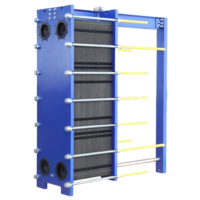Plate Heat Exchangers and Sustainability
Plate heat exchangers (PHEs) play a noteworthy part in advancing maintainability by progressing energy efficiency and decreasing energy utilization in different industrial, commercial, and residential applications. Here’s how PHEs contribute to maintainability by minimizing energy utilization:
Efficient Heat Transfer:
Plate heat exchangers are exceedingly effective devices for transferring heat between two liquids with minimal energy misfortunes. Their compact plan, tall surface area-to-volume proportion, and turbulent flow patterns optimize heat exchange rates, allowing for successful heat exchange whereas minimizing the energy required to preserve desired temperatures.
Heat Recovery:
PHEs are commonly utilized for heat recuperation applications, where squander warm from one prepare or system is captured and utilized to preheat or heat other liquids or spaces. By recovering and reusing waste heat, PHEs offer assistance offset the require for extra energy inputs, diminishing generally energy utilization and nursery gas emissions.
Cogeneration and Combined Heat and Power (CHP) Systems:
In cogeneration and CHP systems, PHEs are utilized to recuperate heat from power generation processes, such as gas turbines or engines, for utilize in heating applications or other industrial processes. This simultaneous generation of electricity and valuable heat improves in general energy efficiency and reduces reliance on fossil fuels.
District Heating and Cooling Networks:
Plate heat exchangers play a pivotal part in area heating and cooling systems, where they encourage the exchange of thermal energy between centralized heat sources (e.g., power plants, industrial facilities) and numerous buildings or clients. By productively dispersing heat energy, PHEs offer assistance optimize energy utilization and reduce the natural impact of heating and cooling systems.
Industrial Processes Optimization:
In industrial processes, PHEs are utilized for precise temperature control, cooling, and warming of handle liquids. By optimizing heat transfer effectiveness and reducing energy misfortunes, PHEs contribute to generally process optimization, leading to energy reserve funds and improved maintainability of industrial operations.
HVAC Systems Efficiency:
PHEs are necessarily components of HVAC systems, where they encourage heat exchange between indoor and open air air streams for heating, ventilation, and air conditioning. By optimizing HVAC system effectiveness and diminishing energy utilization for space conditioning, PHEs help lower carbon emanations and advance environmental sustainability in buildings.
Renewable Energy Integration:
Plate heat exchangers are congruous with different renewable energy sources, such as solar thermal collectors, biomass boilers, and geothermal heat pumps. By proficiently capturing and utilizing renewable heat energy, PHEs back the move to clean, renewable energy sources and reduce dependence on fossil fills.
Water Conservation:
A few PHEs are planned for water-to-water heat exchange applications, where they empower proficient heat transfer between water streams without blending them. This water preservation include diminishes water consumption and wastewater generation, contributing to sustainable water administration practices.
In general, plate heat exchangers play a crucial part in advancing vitality effectiveness, reducing greenhouse gas emissions, and progressing sustainability over diverse applications and businesses. By maximizing heat exchange effectiveness and encouraging the reuse of waste heat, PHEs.

